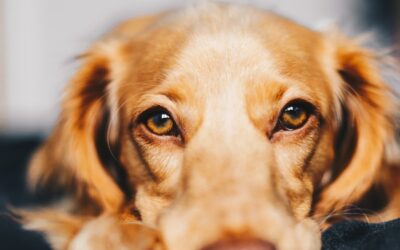Can you imagine how uncomfortable a dog eye infection is? That’s why we want to educate on the symptom’s and solutions to dog eye infection.
Your furry friend’s eyes are the literal windows to their soul, and when those windows are clouded with discomfort, it calls for immediate attention. We understand how integral proactive pet health is to the families who treat their four-legged companions like royalty. This guide will steer you through the watery world of dog eye infections, equipping you with the invaluable knowledge to safeguard your pup’s ocular health.

Understanding the Basics of Dog Eye Infections
Dog eye infections can be alarming not only due to their cosmetic effects but also because they can signal discomfort or potentially serious health issues. An infection or dry eye occurs when a pathogen enters the eye or its surrounding tissues, leading to inflammation, redness, and a range of other symptoms.
When it comes to dog eye health, knowledge is power. Identifying the signs and understanding the potential causes of bacterial eye infections is the first step in maintaining a proactive stance toward your dog’s eye health.

Key Dog Eye Infection Symptoms and Signs
Eye infections in dogs can be uncomfortable, affecting their quality of life and potentially leading to more serious health issues. Recognizing the early signs of eye infections is critical for ensuring timely and effective care. Below are essential symptoms indicating that your dog may be experiencing an eye infection:
-
Redness in the Eye: Redness is a common sign of irritation or infection in the eye. You might notice that the white part of your dog’s eye appears pinker or redder than usual.
-
Abnormal Discharge: An increase in eye discharge, which may be clear or have a yellow or green tint, is a telltale sign of an infection.
-
Light Sensitivity: Dogs with eye infections might squint more than usual or avoid bright areas due to discomfort or pain.
-
Swelling and Squinting: Any noticeable swelling or squinting indicates that your dog is experiencing discomfort, pointing towards an infection or other eye issues.
-
Changes in the Appearance of the Eye: Keep an eye out for any significant alterations in how your dog’s eyes or eyelids look—cloudiness, film over the eye, or changes in eye color can be symptomatic of an infection.
-
Behavioral Changes: A decrease in appetite or less activity can accompany eye issues, suggesting the infection might be affecting your dog’s overall health.
Prompt attention to these signs can help ensure your dog receives the care it needs, facilitating a quicker recovery and preventing further complications.

Common Causes of Eye Infections in Dogs
Eye infections in dogs, medically known as conjunctivitis or “pink eye”, are a frequent concern for dog owners and often require prompt attention to prevent more serious complications. Understanding the underlying causes of these infections can be instrumental in both treating and preventing them for the future. Here are several common causes of eye infections in dogs:
-
Allergies: Much like with ear infections, allergies are a common culprit behind eye infections in dogs. Allergens can irritate the eye, leading to inflammation and infection. Common allergens include pollen, dust, mold, and certain foods.
-
Foreign Bodies: Small particles like dust, sand, or plant material can get into the dog’s eye, causing irritation that may lead to infection. It’s crucial to inspect and clean your dog’s eyes regularly, especially after walks in vegetation-heavy areas.
-
Blocked Tear Ducts: Dogs can experience blockages in their tear ducts which can lead to the accumulation of moisture around the eyes, creating a breeding ground for bacteria and leading to infection.
-
Injury to the Eye: Scratches or trauma to the eye from rough play, skirmishes with other animals, or accidents can introduce bacteria into the eye, resulting in infection.
-
Bacterial, Viral, or Fungal infections: Various pathogens can directly infect the eye, leading to conjunctivitis. Bacterial infections are most common, but viral or fungal agents can also be the cause, particularly in dogs with compromised immune systems.
-
Breed-specific issues: Some dog breeds are predisposed to eye issues due to their facial structure; for example, breeds with protruding eyes or wrinkled skins, like Pugs and Bulldogs, are more susceptible to infections because their eye anatomy can trap dirt and bacteria.
-
Underlying Health Conditions: Chronic illnesses or autoimmune diseases can make a dog more vulnerable to eye infections as part of broader health challenges.
Being mindful of these causes can help dog owners take preventive steps, such as maintaining cleanliness, being alert to the environment their dog explores, and ensuring regular veterinary check-ups. Early detection and treatment is crucial to managing eye infections and safeguarding your dog’s vision and overall wellbeing. If you notice signs of an eye infection in your dog, such as redness, swelling, or discharge, seeking veterinary care promptly is essential for a proper diagnosis and dog eye infection treatment plan.

Maintaining Your Dog’s Eye Health
Keeping your dog’s eyes healthy is crucial for their overall well-being and quality of life. Eyes are sensitive organs that require proper care to prevent infections and other eye conditions. Here are some practical tips to ensure your furry friend’s eyes remain bright and healthy:
Regular Checks:
Make a habit of inspecting your dog’s eyes regularly for any signs of redness, eye discharge, cloudiness, or behavioral changes that might indicate a problem. Early detection can prevent more serious issues.
Cleanliness:
Gently wipe around inner corner of your dog’s eyes with a soft, damp cloth to remove any dirt or debris. Ensure your hands are clean to avoid introducing bacteria.
Trimming Fur:
For breeds with long hair, it’s essential to keep the fur around the eyes trimmed to prevent irritation and reduce the risk of eye infections in dogs.
Protective Gear:
When taking your dog out in potentially hazardous environments, such as for a ride in a convertible or a walk in heavy vegetation, dog owners should consider using protective eyewear like dog goggles to keep their eyes safe from foreign objects and strong wind.
Proper Nutrition:
A balanced diet rich in vitamins and antioxidants can support eye health. Foods that are high in omega-3 fatty acids, such as fish oil supplements, can help maintain good vision.
Avoid Irritants:
Be mindful of shampoos, flea treatments, and medications that may irritate your dog’s eyes. If you’re using anything that could be harmful, protect your dog’s eyes or thoroughly rinse any residues that might get into their eyes.
Routine Veterinary Check-ups:
Regular vet visits are crucial. A professional can examine your dog’s eye health closely and provide advice or treatment for maintaining healthy vision.
Implementing these preventative measures can help you safeguard your dog’s eye health, contributing to their overall happiness and longevity.

Home Remedies: Natural Solutions for A Mild Dog Eye Infection
For the occasional and mild eye irritation, you might consider these home remedies, but always consult your vet first:
Saline Solution
A gentle rinse can help clear irritants and discharge. DIY saline can be made with 1 cup distilled water and 1 teaspoon of salt.
Chamomile Tea Bags
Cooled, used chamomile tea bags can soothe inflamed eyes.
Herbal Extracts
Some, like Oregon grape root, possess natural antibacterial and anti-inflammatory properties.
Omega-3 Fatty Acids
These can reduce inflammation and boost your dog’s overall eye health.
It’s imperative to address any abnormal eye symptoms promptly, and only use home remedies after vet approval.

When to See a Vet: Understanding the Severity and Seeking Professional Help
For sustained or severe symptoms, always defer to professional care. It’s better to be safe than sorry, and in many cases, early intervention can save both your wallet and your pooch from heartache.
Make a beeline for the vet if your dog’s eye infection:
-
Persists or worsens after a day or two
-
Is accompanied by other symptoms, such as lethargy, appetite changes, or behavioral differences
-
Causes your dog visible discomfort
-
Is in a young puppy, elderly dog, or dog with a compromised immune system
Remember, the vet is your ally in ensuring your dog’s well-being, so never hesitate to call upon their expertise.

Snouts and Stouts
Visiting Snouts and Stouts offers dogs the opportunity to exercise and socialize with other dogs in a safe, controlled environment, which is crucial for their physical and mental health.
At the same time, dog owners can enjoy a range of beverages and meet other pet enthusiasts, creating a sense of community. The staff at Snouts and Stouts are trained to ensure the safety and well-being of all pets, and they maintain high cleanliness standards to minimize the risk of infections.
Plus, with regular events and gatherings, it’s a place where both you and your canine companion can make new friends and create lasting memories.

Conclusion: Recap on the Importance of Proactive Eye Care for Dogs
Caring for our dogs is more than just a responsibility; it’s a form of love and companionship. Understanding the intricacies of dog eye infections empowers you to be the best pet parent you can be. Through vigilance, healthy practices, and timely interventions, you can help your dog avoid many common eye problems and infections.
In closing, we encourage incorporating these insights into your dog’s healthcare routine. Regular eye checks, a keen observation of symptoms, and a swift response to any issues will keep those tail-waggers on the bright side of life. Your dedication to their eye health is a testament to the love and loyalty they give us daily, and it’s a bond that deserves nothing less than your best efforts.




